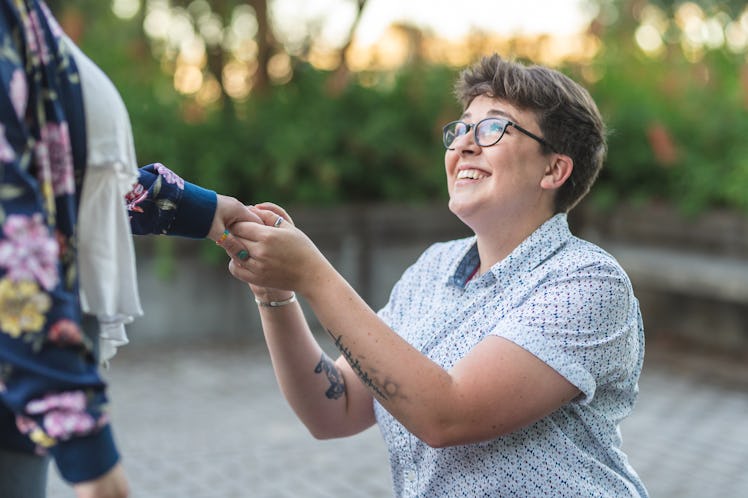
This Is The Real Reason People Get Down On One Knee To Propose
Picture this: You're in a public place, and you see someone drop to one knee in front of their date. Without hearing a single word of their conversation, you instinctively know what's about to happen, because OMG, they are clearly getting down on one knee to propose. It's one of the most iconic, romantic expressions of love, and has become a standard tradition when it comes to engagements. It's all about the knee, the ring, and the question. In fact, a 2017 survey by The Knot showed that 87% of the 14,000 engaged or recently married brides and grooms surveyed reported that they proposed on one knee. When something is so intrinsic to our society, it's not surprising that we accept it without stopping to question why it's a part of proposing and how it came to be. As it turns out, the origins of the tradition date back further than you might expect. Get ready for some serious (and literal) knight in shining armor stuff.
While it's not totally clear exactly where and when the tradition of kneeling to propose began, the act of kneeling as a sign of respect and supplication predates the current era B.C., according to experts. However, it’s largely believed by researchers that its connection to marriage proposals has a relatively more recent history, dating back to the middle ages of the 5th to 15th centuries and its traditions of courtly love. The concept of courtly love actually started in the fiction of the time. Stories from the medieval era featured fanciful tales of nobles, the class of people who ranked second behind royalty, setting out on journeys to perform various deeds to prove their devotion and worthiness to the person they loved. Over time, nobles began to adopt these attitudes and practices from fiction into their own wooing style and practice of "loving nobly."
This practice, which emphasized chivalry, meant that courting for nobles included various romantic gestures such as writing poetry, performing deeds of honor, and acts of service. According to experts on this period, the object of their affection was placed on an idealized pedestal, and courting essentially meant becoming their servant in an effort to prove their worthiness and love. In this case, kneeling was a symbol of surrender and servitude, which by modern standards is a bit much, to say the least.
Kneeling was likely influenced by the traditions of knighthood in this period, as well. Knights would kneel before their lords and genuflect in order to show their commitment, but also to receive honors. So, it follows that bending the knee to propose marriage makes sense, as it's both a request for a "favor" as well as an expression and promise of loyalty. Religion may have also played a role in the creation of the kneeling tradition, as it’s commonly seen as a sign of supplication and devotion across various faiths.
While this tradition may be truly old fashioned, as are many of the ideas that may have inspired it, dropping to one knee in order to ask someone to spend their life with you remains an iconic (and, ultimately, incredibly sweet) gesture of love and commitment to this day. I’m not crying, you’re crying.
Works Cited:
Only 1 in 3 US Marriage Proposals Are a Surprise; Engagement Ring Spend Rises, According to The Knot 2017 Jewelry & Engagement Study. (2017, November 9). Retrieved from https://www.theknotww.com/press-releases/3496/.
Chugg, A. M. (2012). Alexanders lovers. England?: Andrew Michael Chugg.
Boase, R. (1977). The origin and meaning of courtly love: a critical study of European scholarship. Manchester: Manchester University Press.
Hammerling, R. (2008). A history of prayer: the first to the fifteenth century. Leiden: Brill.